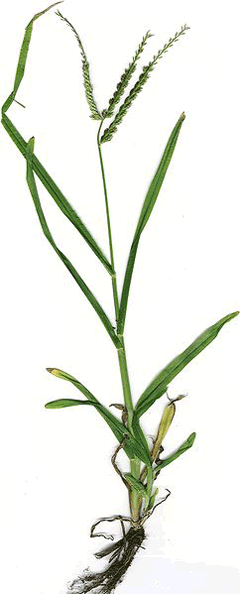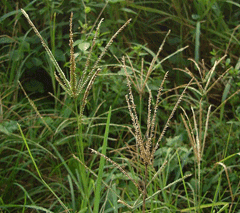 |
|
http://www.hear.org/starr/ |
 |
| http://commons.wikimedia.org/wiki/User:Tau%CA%BBolunga |
Translate this page:
Summary
Main Bloom Time: Early summer, Late summer, Mid summer. Form: Spreading or horizontal.
Physical Characteristics

 Eleusine indica is a ANNUAL growing to 0.5 m (1ft 8in) at a fast rate.
Eleusine indica is a ANNUAL growing to 0.5 m (1ft 8in) at a fast rate.
See above for USDA hardiness. It is hardy to UK zone 9. It is in flower from July to August, and the seeds ripen from August to October. The species is monoecious (individual flowers are either male or female, but both sexes can be found on the same plant) and is pollinated by Wind.
Suitable for: light (sandy), medium (loamy) and heavy (clay) soils and prefers well-drained soil. Suitable pH: mildly acid, neutral and basic (mildly alkaline) soils. It cannot grow in the shade. It prefers moist soil.
UK Hardiness Map
US Hardiness Map
Synonyms
Plant Habitats
Cultivated Beds;
Edible Uses
Edible Parts: Leaves Root Seed
Edible Uses:
Seed - cooked[55, 74, 106]. The seed is rather small[159], it is sometimes used as a famine food[177]. Used as a millet, it can be cooked whole or ground into a flour and used in making cakes, gruels etc[183]. Young seedlings - raw or cooked and used as a side dish with rice[46, 61, 105, 177, 183]. Root - raw[177].
References More on Edible Uses
Medicinal Uses
Plants For A Future can not take any responsibility for any adverse effects from the use of plants. Always seek advice from a professional before using a plant medicinally.
Depurative Diaphoretic Diuretic Febrifuge Laxative
The whole plant, but especially the root, is depurative, diuretic, febrifuge, laxative and sudorific[240, 283]. It is also used in the treatment of liver complaints[240, 283]. The plant is a component of the 'basic remedy' in Vietnamese traditional medicine, it is also used in the treatment of influenza, hypertension, oliguria and retention of urine[283]. The plant can be used fresh or dried[266].
References More on Medicinal Uses
The Bookshop: Edible Plant Books
Our Latest books on Perennial Plants For Food Forests and Permaculture Gardens in paperback or digital formats.

Edible Tropical Plants
Food Forest Plants for Hotter Conditions: 250+ Plants For Tropical Food Forests & Permaculture Gardens.
More

Edible Temperate Plants
Plants for Your Food Forest: 500 Plants for Temperate Food Forests & Permaculture Gardens.
More

More Books
PFAF have eight books available in paperback and digital formats. Browse the shop for more information.
Shop Now
Other Uses
Basketry Paper Weaving
The stems are used to make mats, baskets etc[46, 61, 74]. The plant is suitable for paper manufacture[74].
Special Uses
References More on Other Uses
Cultivation details
Succeeds in ordinary garden soil in a sunny position[200]. This species is the probable ancestor of E. coracana, a species that is cultivated for its seed. A polymorphic species. Special Features:
Invasive, Naturalizing.
References Carbon Farming Information and Carbon Sequestration Information
Temperature Converter
Type a value in the Celsius field to convert the value to Fahrenheit:
Fahrenheit:
The PFAF Bookshop
Plants For A Future have a number of books available in paperback and digital form. Book titles include Edible Plants, Edible Perennials, Edible Trees,Edible Shrubs, Woodland Gardening, and Temperate Food Forest Plants. Our new book is Food Forest Plants For Hotter Conditions (Tropical and Sub-Tropical).
Shop Now
Plant Propagation
Seed - sow early spring in a greenhouse and only just cover the seed. Germination should take place within 2 weeks. Prick out the seedlings into individual pots as soon as they are large enough to handle and plant them out in late spring after the last expected frosts[162, 200]. The seed can also be sown in mid to late spring in situ[200], though if the summer is cool it might not ripen its seed[K].
Other Names
If available other names are mentioned here
Native Range
TEMPERATE ASIA: Oman, Yemen, China, Korea, Japan, Taiwan TROPICAL ASIA: Bhutan, India, Nepal, Pakistan, Indochina, India (Andaman and Nicobar Islands), Myanmar AFRICA: Egypt, Ethiopia, Sudan (south), Kenya, Tanzania, Uganda, Burundi, Cameroon, Democratic Republic of the Congo, Congo, Equatorial Guinea, Rwanda, Benin, Burkina Faso, Côte D‘Ivoire, Ghana, Guinea, Gambia, Guinea-Bissau, Liberia, Nigeria, Senegal, Sierra Leone, Togo, Angola, Mozambique, Malawi, Zambia, Zimbabwe, Botswana, Namibia, Eswatini, South Africa (Eastern Cape, KwaZulu-Natal), Madagascar
Weed Potential
Right plant wrong place. We are currently updating this section.
Please note that a plant may be invasive in one area but may not in your area so it's worth checking.
Conservation Status
IUCN Red List of Threatened Plants Status :

Growth: S = slow M = medium F = fast. Soil: L = light (sandy) M = medium H = heavy (clay). pH: A = acid N = neutral B = basic (alkaline). Shade: F = full shade S = semi-shade N = no shade. Moisture: D = dry M = Moist We = wet Wa = water.
Now available:
Food Forest Plants for Mediterranean Conditions
350+ Perennial Plants For Mediterranean and Drier Food Forests and Permaculture Gardens.
[Paperback and eBook]
This is the third in Plants For A Future's series of plant guides for food forests tailored to
specific climate zones. Following volumes on temperate and tropical ecosystems, this book focuses
on species suited to Mediterranean conditions—regions with hot, dry summers and cool, wet winters,
often facing the added challenge of climate change.
Read More
Expert comment
Author
(L.)Gaertn.
Botanical References
5074200
Links / References
For a list of references used on this page please go here
Readers comment
| Add a comment |
|
If you have important information about this plant that may help other users please add a comment or link below. Only comments or links that are felt to be directly relevant to a plant will be included. If you think a comment/link or information contained on this page is inaccurate or misleading we would welcome your feedback at [email protected]. If you have questions about a plant please use the Forum on this website as we do not have the resources to answer questions ourselves.
* Please note: the comments by website users are not necessarily those held by PFAF and may give misleading or inaccurate information.
To leave a comment please Register or login here All comments need to be approved so will not appear immediately.
|
Subject : Eleusine indica
|
|
|
|